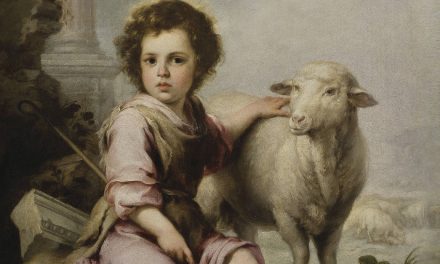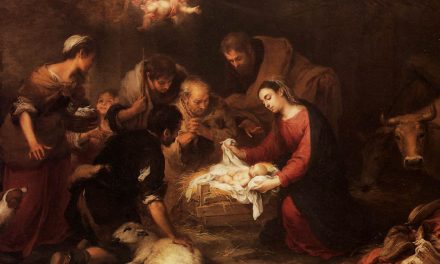Catechesis Corner – Parables Lost: “Once Upon a Time…”
by Sister Jeannine Marie, O.C.D.
Carmelite Sisters of the Most Sacred Heart of Los Angeles
In a world where absolutes like truth, goodness and beauty are denied or cheapened, our children need to have these truths embodied in wonder.
 The parables of Jesus employ simple, ordinary events to present profound and lasting truths.
The parables of Jesus employ simple, ordinary events to present profound and lasting truths.
Many of us can remember those special evenings when we would lie in bed, the covers tucked tightly around us, and mom or dad sitting next to our pillows. They held a large book before our eyes. It contained beautiful illustrations that took up three-fourths of the page with just a few lines of print at the bottom. But oh, that wonderful, ornate letter “O” that loomed so largely before us decorated with vines delicately woven throughout it and with tiny flowers accenting its calligraphy. “Once upon a time,” our parents read, and suddenly we were catapulted into the world of the imagination; a land where wolves blew down houses; ugly ducklings turn to swans; and good always triumphed over evil. This amazing journey through the land of wonder seems sadly lacking in our world today.
In a culture that is inundated with Nintendo Game Boy, Xbox, and Sega’s Game Gear, the skill once used by the mind has moved to the fingers. Ask a child of today, “Who is Jack in the Beanstalk?” and he will answer, “What’s a beanstalk?” Or venture a query about “Billy Goat Gruff ” and they are sure to think that it is the name of a rap group! All of a child’s adventures move before their eyes in a world of 3D. The mind is confined to a 3 x 3 display; trapped in a world preconceived and often violent. The world of “never-neverland” seems to have moved to the silver screen with somewhat questionable results. The end product is a loss of the sense of wonder and the art of storytelling.
Man as Storyteller
Man, in his very nature, is a storyteller. From the most ancient of times man has used the art of storytelling to express himself. Archaeologists have found crude art in cave dwellings that depict not the caveman clubbing his wife but stories of his hunts or surroundings. This largely visual art was found in ancient civilizations as well, which passed on to their children their histories, morals, and customs by way of stories. The Jews, especially the rabbis, became adept in this art. For the most part, it is through the medium of parables that most of our Christian morals have come to us. “There once was a man who had . . .” and all of us will answer “two sons.” Or, “A man was going down from Jerusalem to Jericho, and he fell among robbers . . .”, and we can immediately finish the story. True Christian charity, kindness and the golden rule have all come to us by means of stories.
Why parables?
I believe that Jesus used the art of storytelling not simply as a good Jew, but as a “true man.” Jesus is like us in all things but sin. He celebrated the humanity of man and utilized all of its gifts. The parables of Jesus employ simple, ordinary events to present profound and lasting truths. Man is a unique creature in that he is both body and soul. Grace builds on nature, we are told, and this is clearly seen in the case of parables. Water, bread, and mud are all used to touch the soul of man. Christ touched the ordinary, day-to-day experiences of man and used them to lead him to the deeper truths within. It is the very simplicity of the parable that weds it to the memory. This is also true of the well-written fable or fairytale.
Narnia and Neverland
Why are fables or fairy tales or the novels such as Peter Pan and C.S. Lewis’ Narnia so important to children today? Stories, especially stories of this kind, gift children in two ways. First, the story touches the soul of the child through the window of the senses to imprint upon it deep and lasting truths. In a society where the senses are bombarded with noise, hyper-tactile games, and countless empty slogans, our children need to have their deeper spirits touched. In a world where absolutes like truth, goodness, and beauty are denied or cheapened, our children need to have these truths embodied in wonder. Why wonder? This is the second gift we can give to our children through stories. Wonder opens the mind and heart to be receptive to the “imago Dei,” or the imprint of God on man’s soul. The child can experience, through wonder, what is truly good in man. The sense of wonder, unfortunately, is largely lost in a world where the imagination is forced by the creation of “prepackaged” excitement. Video games and television are the leading sources in today’s milieu. Children, as we know, need to be guided toward the good and not just set free to grapple with an onslaught of ideas loosely bound.
Man is a fallen creature and the tendency to move toward the path of least resistance is present in children as well as adults. The fable or well-written fairytale guides the child through the sense of wonder to the truths that are hidden within. The imagination is free to wander and explore, but always with the guide leading toward truth. It is this very encounter with “truth” that gives the fable or fairytales their lasting quality. The video games will all have turned to cobwebs and dust within our memories, but the encounter with truth is forever. Two thousand years have not faded the impact or dimmed the vision. Our children deserve to come into contact with such wonder and truth.
So, take some time and open up to your children the beauty of stories. Read to them the parables of Our Lord and sit next to their pillows, book in hand, and with their eyes wide with wonder, read “Once upon a time . . .” once again . . . until . . . THE END.
–Sister Jeannine Marie, O.C.D.
Please help us in our mission to assist readers to integrate their Catholic faith, family and work. Tell your family and friends about this article using both the Share and Recommend buttons below and via email. We value your comments and encourage you to leave your thoughts below. Thank you! – The Editors
To learn more about the Carmelite Sisters of the Most Sacred Heart of Los Angeles, read their biography in the left-hand sidebar and visit their website (link provided at the bottom of the bio).
They publish a beautiful print magazine, Spirit of Carmel, and we encourage you to support the work of the sisters with your prayers and through donations and subscriptions to the Spirit of Carmel.
If you are able to help them, please click on the image of their magazine to visit their subscription and donation page.
If you hear God calling you to the religious life, I encourage you to visit their vocations page. – Deacon Mike
Or for more information, please contact:
Sister Grace Helena, OCD, Vocation Directress
920 East Alhambra Road
Alhambra, California 91801













